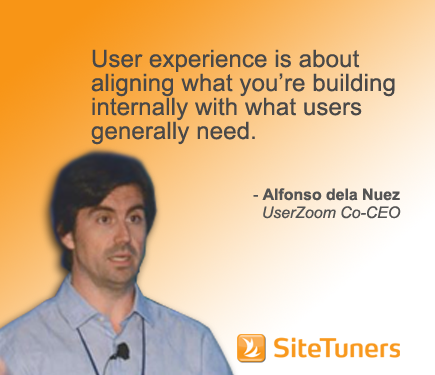
The issue is, they’re not building things for other designers and developers – web sites and mobile apps can be very different from what users expect, and testing adds a lot of value in ensuring the mental models are aligned between those building something and the target users. Done correctly, web sites and mobile apps will not add a lot of cognitive load to the tasks a user needs to perform – users are supposed to find the tasks easy to perform without thinking too much.
Not One and Done
Before, testing used to be more of a one-time thing, say, after a redesign is completed. Today, UserZoom, for example, has clients doing weekly usability testing – the nature of usability testing has changed.
What UserZoom is observing is that both in mature and immature companies, monthly tests are becoming more common practice – companies are seeing the value of iterative tests as opposed to one and done deals.
Usability Testing Versus Landing Page Testing
Usability tests are radically different from split tests. Usability tests, where a user gets asked to perform a particular task and usability issues are uncovered, tend to work well when paired with split tests to measure conversion differences between page A and page B. Alfonso notes that using usability tests wouldn’t just tell you which page is performing better, it’ll also cover why something is performing better.
Split tests are good, but you have to go beyond that to really understand and engage the end-user and that you do with user testing, usability, and user experience research.
User Experience: Audience Research, Benchmarking, and UX Testing
Alfonso adds that there are a few different parts to fixing the UX.
One of them is user research – understanding who visits your site and why they’re coming to your site.
Another one is usability benchmarking, or measuring how well users can perform their tasks. This gets into time on task, task success rates, satisfaction, and other usability measures.
The third aspect is prototypes for redesigns – ensuring that you capture the user’s mental model by creating prototypes of what the final product will be, and then doing card sorts and other tests while you’re in the design process. Mistakes caught early in the process are cheap to fix; mistakes caught later in the process can be costly to correct.
Controlled Research, In the Wild Research: The dangers of asking a user to perform a task
Tim notes that there’s the Heisenberg uncertainty principle problem, that observing users is similar to observing photons – you change the user behavior by observing the user, just as you change the photon speed by observing the photon speed. Tim is concerned that users will behave very differently in controlled environments than when they are “in the wild.”
Alfonso agrees that that’s a risk – there’s value to observing data in the wild. However, he points out that to be fair, research is research and it’s never going to be the real thing. All people are being observed or are asked to participate, but researchers need to get as close to the real situation as possible.
There are also things researchers can do to compensate. For instance, for time-critical tasks, researchers can ask the user to do whatever he or she can to perform a task in under 2 minutes, to simulate some of the real world attention-span. Likewise, there’s the 5-second test – getting users to look at something for 5 seconds, to check visual prioritization when the user gets asked about what 3 things stand out.
Regardless of whether you do more of controlled or in the wild research, though, Tim and Alfonso both agree that even informal tests can get your company a long way into the optimization process, and that with the proliferation of cheap tools, there’s no excuse not to get started.


